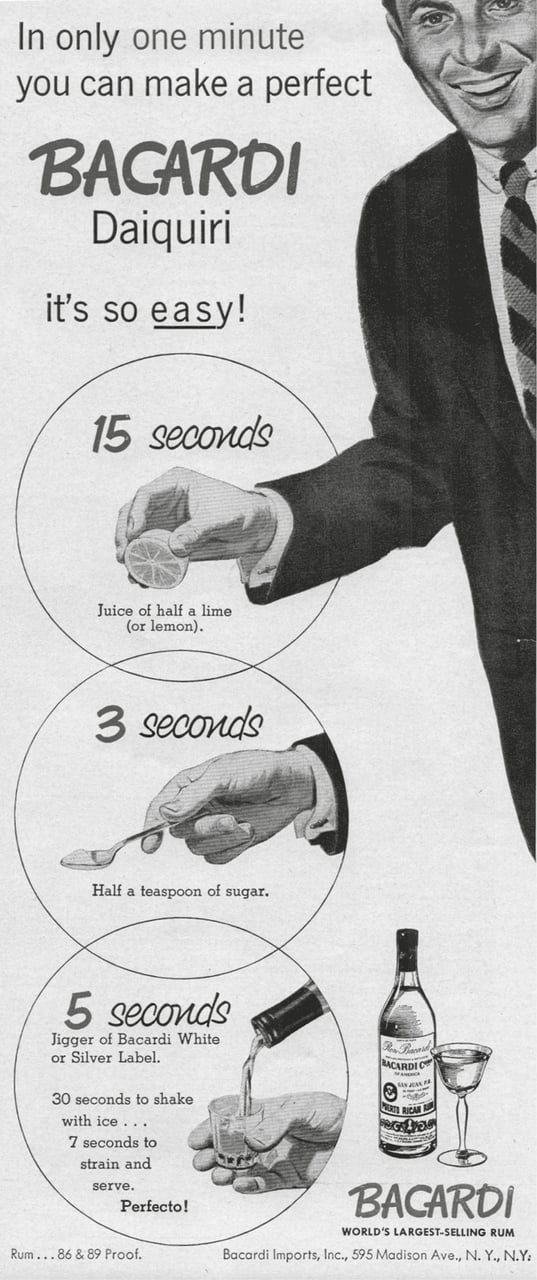The Daiquiri is the king of Cuban cocktails and simplicity itself: rum, lime juice, and sugar. From its fluke birth at a Cuban iron mine to its glory days as the favorite drink of Ernest Hemingway and the Kennedy White House—and from its devolution into a creamy disco drink to its rehabilitation at the hands of craft cocktail revivalists—the Daiquiri has endured to take its rightful place alongside the Martini and the Manhattan as the quintessence of satori in a stemmed glass.
People in the Caribbean had been combining rum, lime, and sugar for over two hundred years before Jennings Stockton Cox Jr. (1866–1913) made the first Daiquiri—or at least supervised its making—in 1896, so it’s a stretch to call him the drink’s father. But he was at least its midwife. Cox ran John D. Rockefeller’s Spanish-American Iron Company near Daiquiri, a harbor town on Cuba’s east coast. According to Cox’s step-granddaughter Carmen Puig, who in 1970 told the story to Time-Life cookbook author Linda Wolfe, Cox improvised the drink for some American visitors after discovering he was out of gin. He did have Bacardi Carta Blanca rum, fresh from the distillery twenty-eight miles away in Santiago, “but he feared that it would not be to the taste of the Americans. To disguise the rum somewhat, he picked limes from a tree in his garden, added some juice and some sugar to his rum,” then swizzled it all in a pitcher with shaved ice. He may have had help in the process: as Robert H. Lyman Jr., who was one of the six Yanqui engineers on Cox’s staff at the mine, recalled in 1935, the drink was more of a group creation with credit to be shared among the “Siete Solteros,” the “Seven Bachelors,” as Cox and his crew were known. In any case, “It was an immediate success.” See Caribbean.
While their details vary, newspaper accounts from the 1920s through the 1950s quote other sources who confirm Cox’s obstetrics—and note that for twelve years after he first made the drink, he’d never thought to name it, just calling it his “rum sour.” He had, however, been introducing it to the bars of Santiago. There the bartender at the San Carlos Club streamlined Cox’s pitcher full of rum, lime, and sugar into a single-serving drink; according to a chemist named Josh Linthicum, who worked and drank with Cox, in 1908 that same bartender finally gave the drink a name: “Ron à la Daiquiri.” A slightly different account, in Basil Woon’s 1928 book Shortly after Repeal, Ribalaigua employed the latest in cutting-edge culinary technology—the electric blender—to create the first frozen Daiquiris. His Daiquiri no. 3, frappéd with maraschino and grapefruit juice, beguiled Ernest Hemingway, who began drinking them in 1938 and didn’t stop until shortly before his death in 1960. (Hemingway’s customized version, with no sugar and double the rum, became famous as the “Papa Doble.”) See Hemingway Daiquiri. The Daiquiri’s star rose even higher when President John F. Kennedy cited it as his favorite preprandial drink. But the industrial food complex of the 1970s—coupled with the disco era’s penchant for sweet, fruity, lactic cocktails—deformed the Daiquiri beyond recognition with artificial sour mix, frozen strawberries, and whipped cream. The drink languished in this state until the beginning of the twenty-first century, when the burgeoning craft cocktail renaissance brought the classic Cuban shaken-and-strained version back onto American bar menus. See craft cocktail. Recipe: Stir one teaspoon (5 ml) sugar into the juice of half a lime (ca. 15 ml), add 60 ml white rum, shake with ice and strain into a cocktail glass. See also maraschino and Ribalaigua y Vert, Constante. Berry, Jeff. Potions of the Caribbean. New York: Cocktail Kingdom, 2014. Cuddy, Jack. “Cuba’s Cocktail King Tells Cuddy Daiquiri Recipe.” Rome (NY) Sentinel, May 3, 1937. Fougner, G. Selmer. “Along the Wine Trail.” New York Sun, February 11, 1935, 29. Pegler, Westbrook. “Fair Enough.” Billings Gazette, October 23, 1956. “What’s in a Name.” All Hands: The Bureau of Naval Personnel Information Bulletin, April 1951, 54. By: Jeff Berry Instructions for making a Daiquiri from 1952, and sound ones. Source: Wondrich Collection.
Instructions for making a Daiquiri from 1952, and sound ones. Source: Wondrich Collection.
